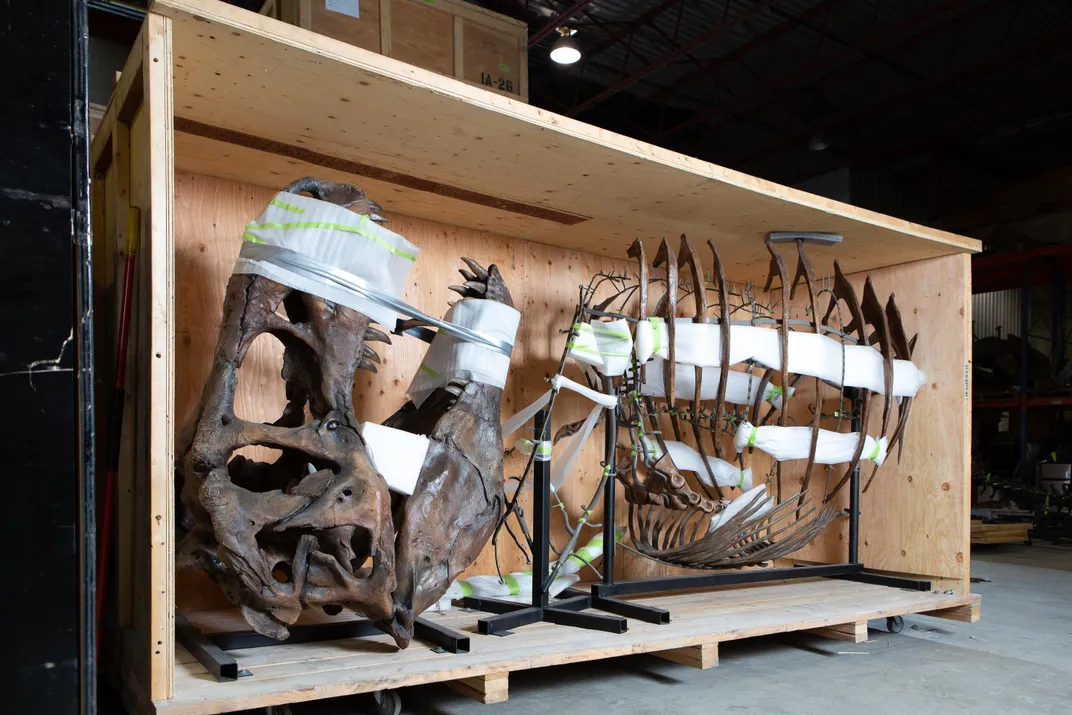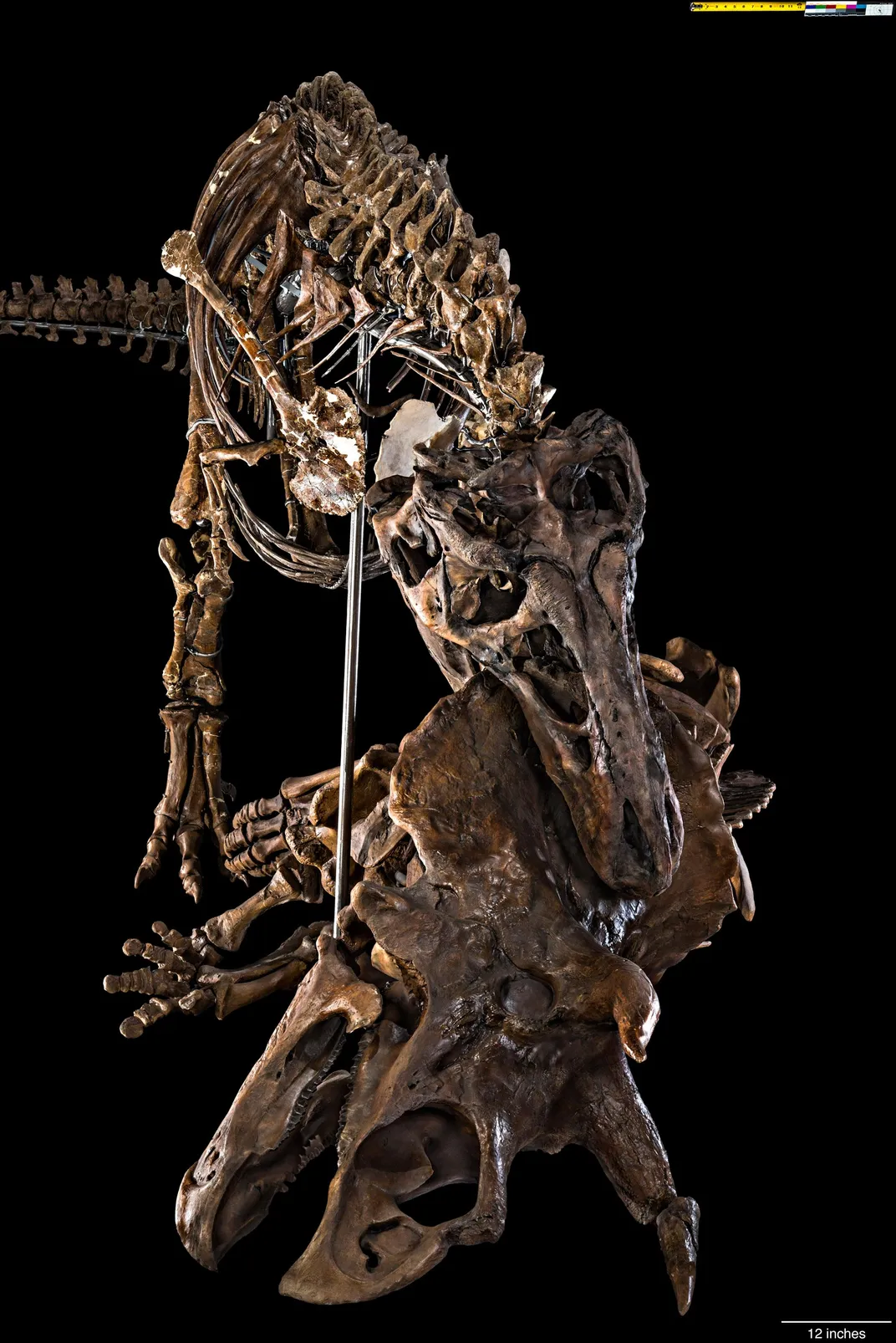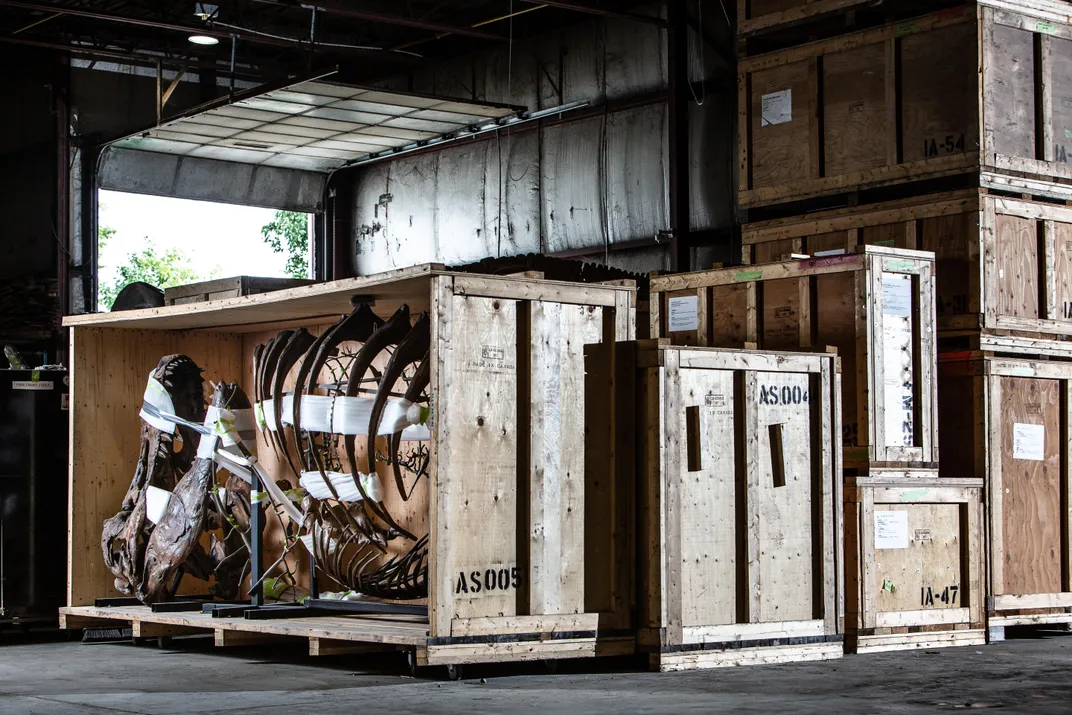Homecoming King: The Nation’s T. rex Returns to the Smithsonian
The fully assembled skeleton will be displayed for the first time at the National Museum of Natural History in June 2019.
:focal(2585x957:2586x958)/https://tf-cmsv2-smithsonianmag-media.s3.amazonaws.com/filer/89/99/89991deb-104b-4dc2-8773-856392e1d8b6/nhb2017-00021.jpg)
Just a couple inches closer and it’s all over for this Triceratops. Towering overhead, the Tyrannosaurus rex looms large and menacing, one stabilizing foot planted firmly onto the Triceratops’ flank, as its monstrous maw descends to tear its victim’s head from its frilly shoulders.
It’s the gut-wrenching theater of macabre, enough to raise the hairs on the back of anyone’s neck. The good news? The pair, frozen in this frightful snapshot, will soon be on display for all the world to see.
Today, the National Museum of Natural History unveiled a sneak peek of the “Nation’s T. rex” in its momentous return to Washington, D.C. after a four-year hiatus. It also announced that the newly renovated “David H. Koch Hall of Fossils—Deep Time” will open to the public on Saturday, June 8, 2019, a debut that will include the first fully assembled T. rex skeleton to be on display at the Smithsonian. The patriotically-named dinosaur returns after a few years abroad—but rex hasn’t squandered its time soaking up the sights. The fossils of this T. rex have spent the last four years being meticulously assembled by a team of scientists in Canada.
The new Hall is named in honor of philanthropist David H. Koch, who made a generous contribution of $35 million, the largest single donation in the Museum's history. The entire project is projected to cost $125 million.
“Our dinosaurs are coming home,” says the Museum’s director Kirk Johnson at a preview of the hall today. And not just to any home: the new hall will reopen as what Johnson describes as the “most visited room in the most visited natural history museum in the world.” As a whole, the Museum delights 7 million patrons from around the world each year.

For now, the T. rex is not yet assembled into its final form: The skeleton only recently arrived back on American soil, bones parceled out between a dizzying number of crates that await unpacking. The display will eventually yield a formidable and fully-formed beast standing at about 15 feet tall and 40 feet long, poised to glut on the body of an unlucky Triceratops. This cinematic scene will take about a month to assemble—but the exhibit has already been decades in the making.
In 1988, rancher Kathy Wankel was baffled to stumble upon the pristine skeleton of a Tyrannosaurus rex while enjoying an innocent hike with her family in Montana’s Fort Peck reservoir. Because they were on federal property, Wankel quickly notified the authorities. Over the next two years, the newly dubbed “Wankel rex” was carefully excavated by a team of paleontologists led by Jack Horner from the Museum of the Rockies in nearby Bozeman. For nearly 20 years, the 66-million-year-old fossils held tenure in the Montana museum, splayed in the original configuration in which the bones had been found—the T. rex’s “death pose.”
But five years ago, the Smithsonian’s Museum of Natural History finalized a 50-year loan agreement with the U.S. Army Corps of Engineers to display the Wankel rex in the nation’s capital, securing what Johnson calls “the first significant addition to the fossil hall since 1981.”
And so, in 2014, seven tons of fossils began a lumbering 2,000-mile weekend road trip from Montana to Washington, D.C., nestled in the back of a hefty FedEx 18-wheeler emblazoned with a grandiose tagline: “Delivering History.” The Nation’s T. rex was (re)born.
Upon the T. rex’s arrival at the Museum, hundreds of bones were carefully unwrapped from a veritable bevy of packing material required to withstand the turbulent trip. The fossils were first 3D-scanned to generate a lasting digital rendering of the skeleton that could be studied past the lifespan of the precious, material bones.

Some fortunate patrons who visited the Museum between the months of April and October of 2014 had the chance to see the scanning process in action in an annexed Rex Room. But by fall of that year, the daunting dino mascot was again on the move— this time, crossing international borders in a hard detour to the Great White North. Before rex could premiere to the public, it first needed to be fitted for its debutante dress: A set of custom metal frames for each individual bone, cradling the delicate fossils while anchoring them to the scaffold of its final choreography.
This task fell to Ontario’s Research Casting International, an aptly named firm with a prestigious history of assembling dinosaurs for museums around the world. It’s a game of Jenga with incomprehensible stakes. Gone are the days when curators drilled holes into fossils to install binding ropes and bars (a fate tragically endured by many of the former Hall’s original specimens): The goal now is to preserve—not only for display purposes, but also so scientists can still access the individual specimens for future research. Thus, each of the metal ligaments that secures the fossils is removable.
Complicating matters was the issue of theatrics. The Montana “death pose” may have been accurate, but Smithsonian curators were determined to maneuver the bones into a configuration that displayed T. rex in all its former glory—something at the intersection of realistic and visually striking, all while being mindful of the irreplaceable fossils themselves. Fortunately, much of the finagling could be done digitally, thanks to the Museum’s 3D scans. But the question remained: How would rex regale? It was truly the world’s most intimidating jigsaw puzzle.
But then arose the idea of adding a second player: a Triceratops. It was a unique scenario—something no other museum had executed before, positioning two dinosaurs in a fight that would have happened 66 to 68 million years ago. “It allowed us to do something no one’s done yet with a T. rex: these two animals directly engaged,” explains Matthew Carrano, the Museum’s curator of dinosaurs.
Upon closer inspection, the Triceratops underfoot may seem familiar to the most zealous of natural history buffs. Nicknamed “Hatcher” for his paleontologist discoverer, the Triceratops in question has been on display at the Smithsonian since 1905, albeit usually in less precarious situations. In truth, Hatcher is actually a not-so-secret clone, cast from a cobbling of different Triceratops skeletons in 1998; yet another replica will be the one to join the Wankel rex in Hatcher’s final matinee.

In addition to a partial decapitation, Hatcher will sport a broken horn and a couple fractured ribs—a grisly indication of the T. rex’s staggering power. But the Triceratops’ fate may have already been sealed: It’s unclear whether T. rex is poised to deliver a fatal blow, or simply capitalizing on some conveniently located roadkill.
Although T. rex is recognized as the largest carnivore in western North American during its time, scientists are not sure whether the tyrant king was more of a predator or a scavenger; the two certainly aren’t mutually exclusive. So, while it’s plausible that a Triceratops would have comprised a typical T. rex treat, the nature of their interaction—and whether the Triceratops had already been felled by some other malady first—is left up to the imagination. The send-off seems grim, but no one can say Hatcher isn’t retiring in style.
Once Carrano and Research Casting International were satisfied with this climactic rendering, the team then disassembled the duo and prepared them for the return trip to D.C.
While the Wankel rex was on sabbatical, the Museum seized the opportunity to revamp the entirety of its century-old fossil hall, hoping to reinvigorate the exhibition with the latest paleontological science in time to coincide with the return of rex. And so began the largest, most extensive renovation in museum history. When the new Koch Hall of Fossils reopens in June 2019, it will reveal a completely refurbished 31,000-square-foot space stocked floor-to-ceiling with dazzling fossils from eras gone by—centered around the Nation’s T. rex as its breathtaking pièce de résistance. Over 700 specimens of animals, plants and insects will accompany the T. rex in showcasing the 3.7 billion years of life thus far on Earth.
“The history of life has always been rich and diverse and complicated as it is today, just without humans,” says Kathy Hollis, the Museum’s national fossil collections manager. “We’re just a blip or a moment in the Earth’s history. We have the consciousness to think about that, and put ourselves in context of history and future.”
Although 80 to 85 percent of this T. rex (at least, by size) was recovered in the excavation, several of the fossils, including the head and most of the ribs, are too fragile for display. Just over half of the bones that are ultimately unveiled to the public will be bona fide dino; carefully reconstructed synthetics will fill in the gaps. For the bones for which there is no true counterpart, Carrano and his team have appended approximations with the utmost accuracy, either drawing from mirror images in the dinosaur’s anatomy or modeling on other T. rex skeletons from separate excavations.
The Wankel rex surfaced at an opportune juncture in the timeline of paleontological technology. With the mostly intact skeleton, scientists eagerly expanded their knowledge of Tyrannosaurus, including the first physical forearm specimen in history. What’s more, we now know the Nation’s T. rex died when it was about 18 years old. Delightfully, the age of a dino tracks like a tree: simply saw through a bone and count its rings. Its cause of death and sex, though, remain mysterious.
However, Carrano believes there is more to come. “Undoubtedly there are still things we’re going to learn from it,” he says.
This is an emotional time for Carrano: the re-opening of the fossil hall is a culmination of his career at the Smithsonian thus far, a project he has invested in since 2002.
“It’s still a little surreal: You spend so much time thinking about it, having meetings, planning for things—there’s so many people involved, and you’re focusing on every tiny detail,” he reflects. “And then you forget to imagine what it’s like when it’s all done. In one way or another, I’ve been thinking about this for over 16 years. It’s like sending a kid off to college.”
In the coming weeks, the Nation’s T. rex will be reassembled in its new home, allowing the rest of the Koch Hall of Fossils to reshape around its centerpiece. When the Hall opens next June, the Wankel rex will finally reveal itself to the public, hopefully bringing with it a resurgence of dino fever at the Smithsonian. But luckily for Hatcher—and the rest of the world—both Triceratops and Tyrannosaurus will remain frozen for the foreseeable future: no one’s getting eaten just yet.
/https://tf-cmsv2-smithsonianmag-media.s3.amazonaws.com/accounts/headshot/10172852_10152012979290896_320129237_n.jpg)
/https://tf-cmsv2-smithsonianmag-media.s3.amazonaws.com/accounts/headshot/10172852_10152012979290896_320129237_n.jpg)